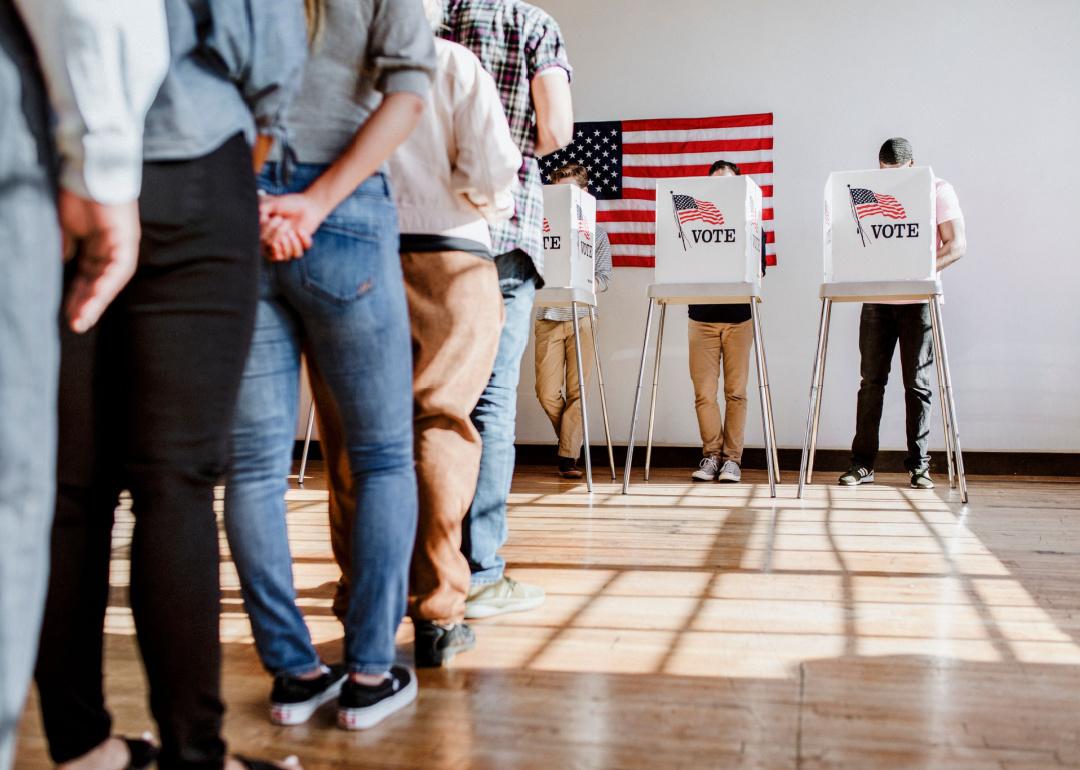
1.4 million votes: See the demographics of Nebraska's voting population
1.4 million votes: See the demographics of Nebraska's voting population
In 2020, 158.4 million citizens—almost two-thirds of estimated eligible voters—voted in the presidential elections, according to the Pew Research Center. The number represented a higher than average turnout, with people voting in numbers not seen since 1980 and possibly well before.
Stacker compiled voter demographics for each state and Washington, D.C., using the 2019 U.S. Census Bureau's American Community Survey (released in September 2020). Each slide shows the state's voting-eligible population (citizens who are 18 or older) and the breakdown of that population by sex, age, race, and education. Economic statistics are not included because the American Community Survey does not account for COVID-19, which affected unemployment, poverty, and medical insurance status for millions of Americans. In order to avoid making any assumptions about the data or the participants of the American Community Survey, Stacker used the exact wording of the "race" and "sex" framework that was provided in the census data.
Keep reading to see the voter demographics of your state.
Nebraska by the numbers
- Voting-eligible population: 1,388,950
- Breakdown by sex: 49.2% male, 50.8% female
- Breakdown by age: 21.5% 18-29 years old, 24.5% 30-44 years old, 31.7% 45-64 years old, 22.3% 65+ years old
- Breakdown by race: 89.8% White, 4.1% Black or African American, 1.6% Asian, 6.7% Hispanic or Latino, 0.0% Native American or Alaska Native, 0.0% Native Hawaiian or Pacific Islander, 1.8% two or more races
- Breakdown by education: 2.1% less than high school education, 4.4% some high school (no diploma), 26.2% high school graduate or equivalency, 25.1% some college (no degree), 10.9% associate's degree, 21.2% bachelor's degree, 10.1% graduate or professional degree
Nebraska's collective voting turnout, including sex, age, race, and education, was 63% in the 2016 general election, higher than the national average. While the North Central region of Nebraska saw the most massive turnout, of all Cornhusker State Counties, Arthur and Loup saw the highest, while Thurston and Wayne had the lowest. Like every state, Nebraska's voting turnout rises with age, with 65-and-older voters hitting the polls at 76% for the 2016 general election.
By percentage, voters aged 45–64 are the highest in every state, with registered voters over the age of 45 comprising more than half the country's population. Older voters also trend toward turning out to vote at a higher rate and played a significant role in former President Donald Trump's 2016 victory in Florida.
Along racial lines, Black or African American voters in Louisiana and Georgia comprise more than 30% of the state's registered voters. California and Texas—which award the most electoral votes at 55 and 38, respectively—boast the highest numbers of Latino voters. On the other end of the spectrum, West Virginia and Maine boast the highest percentage of white voters. A number of states had already seen record voter turnouts, with 16 seeing more than half of its registered voters casting a ballot before Election Day.
Continue reading for a glimpse into the voter demographics of neighboring states.
South Dakota
- Voting-eligible population: 653,394
- Breakdown by sex: 50.2% male, 49.8% female
- Breakdown by age: 20.6% 18-29 years old, 24.0% 30-44 years old, 32.0% 45-64 years old, 23.5% 65+ years old
- Breakdown by race: 88.1% White, 1.5% Black or African American, 0.9% Asian, 2.3% Hispanic or Latino, 0.0% Native American or Alaska Native, 0.0% Native Hawaiian or Pacific Islander, 0.0% two or more races
- Breakdown by education: 2.2% less than high school education, 5.7% some high school (no diploma), 30.8% high school graduate or equivalency, 22.7% some college (no degree), 11.3% associate's degree, 19.2% bachelor's degree, 8.1% graduate or professional degree
With only three electoral votes, South Dakota has a high percentage of white voters and a low rate of minority voters. Though South Dakota has a collective voting demographic of 27.3% holding either bachelor's, graduate, or professional degrees, the 2018 midterm election showed no distinct correlation between education level and voting preference.
Wyoming
- Voting-eligible population: 434,852
- Breakdown by sex: 50.7% male, 49.3% female
- Breakdown by age: 20.7% 18-29 years old, 24.6% 30-44 years old, 32.1% 45-64 years old, 22.6% 65+ years old
- Breakdown by race: 93.0% White, 7.7% Hispanic or Latino, data not available for other races
- Breakdown by education: 1.3% less than high school education, 4.5% some high school (no diploma), 30.5% high school graduate or equivalency, 25.8% some college (no degree), 11.2% associate's degree, 17.4% bachelor's degree, 9.2% graduate or professional degree
Of all U.S. states, Wyoming has the lowest population, slimming down its collective voting pool. However, unlike other regions where the populace affects electoral votes, Wyoming is notably overrepresented in the Electoral College, which has caused some concern in past elections. White voters account for a large majority of the ballots cast in Wyoming, which has voted Republican in every presidential election since 1952 except for one.



